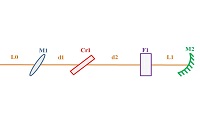Instability Risk and Beam Profile Variation in Optical Ring Resonator due to Thin Gradient Index Lens
DOI:
https://doi.org/10.46604/peti.2021.6551Keywords:
optical ring resonator, GRIN lens, resonator stability, ABCD matrix, beam propagation microstripAbstract
In this study, a simple ring resonator model in presence of thin gradient index (GRIN) lens is investigated to characterize the optical beam maginification quality beyond its traditional modalities. This model allow us to vary and control the limit of resonator stability more significantly.It consist of two folding arms and each arm can be realized by its cavity components. Insertation of thin GRIN lens ( thickness < 9.3mm) in ring resonator, mainly in between first folding range gives the magnified output beams and meets the beam expander feature for the laser. Variation of GRIN lens thickness (L) is an emphatic and influencing parameter than its refractive index (n) to disturb the resonator stability. Resonator stability in Tangential (T) plane is relatively more sensitive than sagittal (S) plane. Vigorous magnification in optical beam size at the end of output range in a cavity is the noticeable consequences because of GRIN lens.
References
Y. Jiang, Y. Mei, Y. Zou, Y. Zuo, and S. Du, “Intracavity Cold Atomic Ensemble with High Optical Depth,” Review of Scientific Instruments, vol. 90, no. 1, pp. 013105–1-013105–7, January 2019.
J. Ye, C. J. Hood, T. Lynn, H. Mabuchi, D. W. Vernooy, and H. J. Kimble, “Quantum Manipulation and Measurement of Single Atoms in Optical Cavity QED,” IEEE Transactions on Instrumentation and Measurement, vol. 48, no. 2, pp. 608-612, May 1999.
A. Mills, S. Zhdanovich, M. X. Na, F. Boschini, E. Razzoli, M. Michiardi, et al., “Cavity-Enhanced High Harmonic Generation for Extreme Ultraviolet Time and Angle-Resolved Photoemission Spectroscopy,” Review of Scientific Instruments, vol. 90, no. 8, pp. 083001–1-083001–9, August 2019.
B. Liu, H. Zhou, L. Liu, X. Wang, M. Shan, P. Jin, and Z. Zhong, “An Optical Fiber Fabry-Perot Microphone Based on Corrugated Silver Diaphragm,” IEEE Transactions on Instrumentation and Measurement, vol. 67, no. 8, pp. 1994-2000, August 2018.
C. Zhu, Y. Zhuang, Y. Chen, and J. Huang, “A Liquid-Level Sensor Based on a Hollow Coaxial Cable Fabry-Perot Resonator with Micrometer Resolution,” IEEE Transactions on Instrumentation and Measurement, vol. 67, no. 12, pp. 2892-2897, December 2018.
A. Cygan, P. Wcisło, S. Wojtewicz, G. Kowzan, M. Zaborowski, D. Charczun, et al., “High-Accuracy and Wide Dynamic Range Frequency-Based Dispersion Spectroscopy in an Optical Cavity,” Optics Express, vol. 27, no. 15, pp. 21810-21821, July 2019.
G. Gagliardi and H.-P. Loock, Cavity-Enhanced Spectroscopy and Sensing. Springer Series in Optical Sciences 179, Heidelberg: Springer-Verlag Berlin Heidelberg, 2014.
V. Van, T. A. Ibrahim, K. Ritter, P. P. Absil, F. G. Johnson, R. Grover, et al., “All Optical Nonlinear Switching in GaAs-AlGaAs Microring Resonators,” IEEE Photonics Technology Letters., vol. 14, no. 1, pp. 74-76, January 2002.
R. W. Boyd and J. E. Heebner, “Sensitive Disk-Resonator Photonic Biosensor,” Applied Optics, vol. 40, no. 31, pp. 5742-5747, December 2001.
B. E. Little, S. T. Chu, H. A. Haus, J. Foresi, and J.-P. Laine, “Micro-Ring Resonator Channel Dropping Filters,” Journal of Lightwave Technology, vol. 15, no. 6, pp. 998-1005, April 1997.
J. E. Heebner, V. Wong, A. Schweinsberg, R. W. Boyd, and D. J. Jackson, “Optical Transmission Characteristics of Fiber Ring Resonators,” IEEE Journal of Quantum Electronics, vol. 40, no. 6, pp. 726-730, June 2004.
R. H. Dicke, Molecular Amplification and Generation Systems and Methods, U. S. Patent, 2 851 652, September 9, 1958.
A. M. Prokhorov, “Molecular Amplifier and Generator for Submillimeter Waves,” Journal of Experimental and Theoretical Physics, vol. 7, no. 6, pp.1658-1659, June 1958.
A. L. Schawlow and C. H. Townes, “Infrared and Optical Masers,” Physical Review., vol. 112, no. 6, pp.1940-1949, December 1958.
G. D. Boyd and J. P. Gordon, “Confocal Multimode Resonator for Milli Meter Through Optical Wavelength Masers,” The Bell System Technical Journal, vol. 40, no. 2, pp. 489-508, March 1961.
G. D. Boyd and H. Kogelnik, “Generalized Confocal Resonator Theory,” The Bell System Technical Journal., vol. 41, no. 4, pp. 1347-1369, July 1962.
A. G. Fox and T. Li,“Resonant Modes in a Maser Interferometer,” The Bell System Technical Journal., vol. 40, no. 2, pp. 453-488, March 1961.
J. R. Pierce, “Modes in Sequences of Lenses,” Proceeding of the National Academy of Sciences of the United States of America, , National Academy of Sciences Press, November 1961, pp. 1808-1813.
G. Goubau, “Optical Relations for Coherent Wave Beams,” Electromagnetic Theory and Antennas, New York: Mac Millan, June 1962, pp. 907-918.
H. Kogelnik, “Imaging of Optical Modes-Resonators with Internal Lenses,” The Bell System Technical Journal, vol. 44, no. 3, pp. 455-494, March 1965.
H. Kogelnik and T. LI, “Laser Beams and Resonators,” Applied Optics, vol. 5, no. 10, pp.1550-1557, October 1966.
“reZonator Application,” www.rezonator.orion-project.org, June 5, 2020.
S. N. B. Tushar, S. D. Nath, J. Akhtar, and M. I. Reja, “Modelling and Analysis of Z- Folded Solid State Laser Cavity with Two Curved Mirrors,” International Journal of Microwave and Optical Technology, vol.13, no.3, pp. 244-253, May 2018.
K. A. Khan and S. M. Nokerov, “Analysis of Gaussian Beam Profile and its Amplification in Ring Resonator with Thin Gradient-Index Lens,” Modern Means of Communications, Materials of the 25th International Scientific and Technical Conference, Belarusian State Academy of Communications Press, October 2020, pp. 42-44.

Published
How to Cite
Issue
Section
License
Submission of a manuscript implies: that the work described has not been published before that it is not under consideration for publication elsewhere; that if and when the manuscript is accepted for publication. Authors can retain copyright of their article with no restrictions. Also, author can post the final, peer-reviewed manuscript version (postprint) to any repository or website.

Since Oct. 01, 2015, PETI will publish new articles with Creative Commons Attribution Non-Commercial License, under The Creative Commons Attribution Non-Commercial 4.0 International (CC BY-NC 4.0) License.
The Creative Commons Attribution Non-Commercial (CC-BY-NC) License permits use, distribution and reproduction in any medium, provided the original work is properly cited and is not used for commercial purposes







